Contemporary Business Economics Analysis: Demand, Supply, Theories
VerifiedAdded on 2022/08/24
|12
|3289
|16
Report
AI Summary
This report analyzes contemporary business economics, focusing on microeconomic concepts like the law of demand and supply within the UK retail sector, specifically referencing Tesco. It examines movements along demand and supply curves and shifts in these curves due to various market factors, including price changes, consumer preferences, and technological advancements. The report then contrasts and compares economic theories and models of the 20th and 21st centuries, discussing the impact of fiscal and monetary policies, new growth theory, and the development of environmental economics. It highlights the influence of these theories on modern business practices, particularly in the context of the UK market and global environmental concerns. The report uses diagrams and examples to illustrate these economic principles and their practical applications.
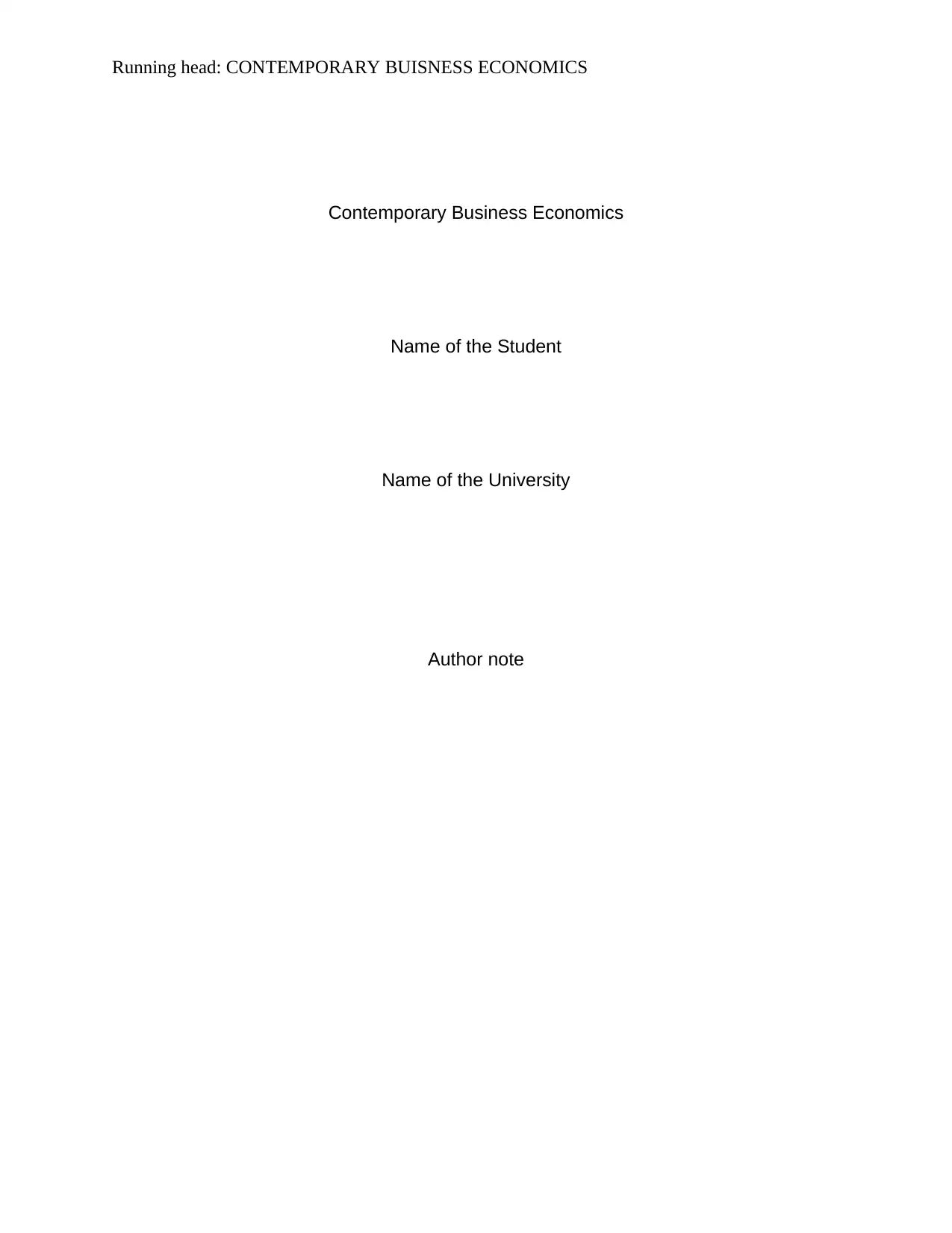
Running head: CONTEMPORARY BUISNESS ECONOMICS
Contemporary Business Economics
Name of the Student
Name of the University
Author note
Contemporary Business Economics
Name of the Student
Name of the University
Author note
Paraphrase This Document
Need a fresh take? Get an instant paraphrase of this document with our AI Paraphraser
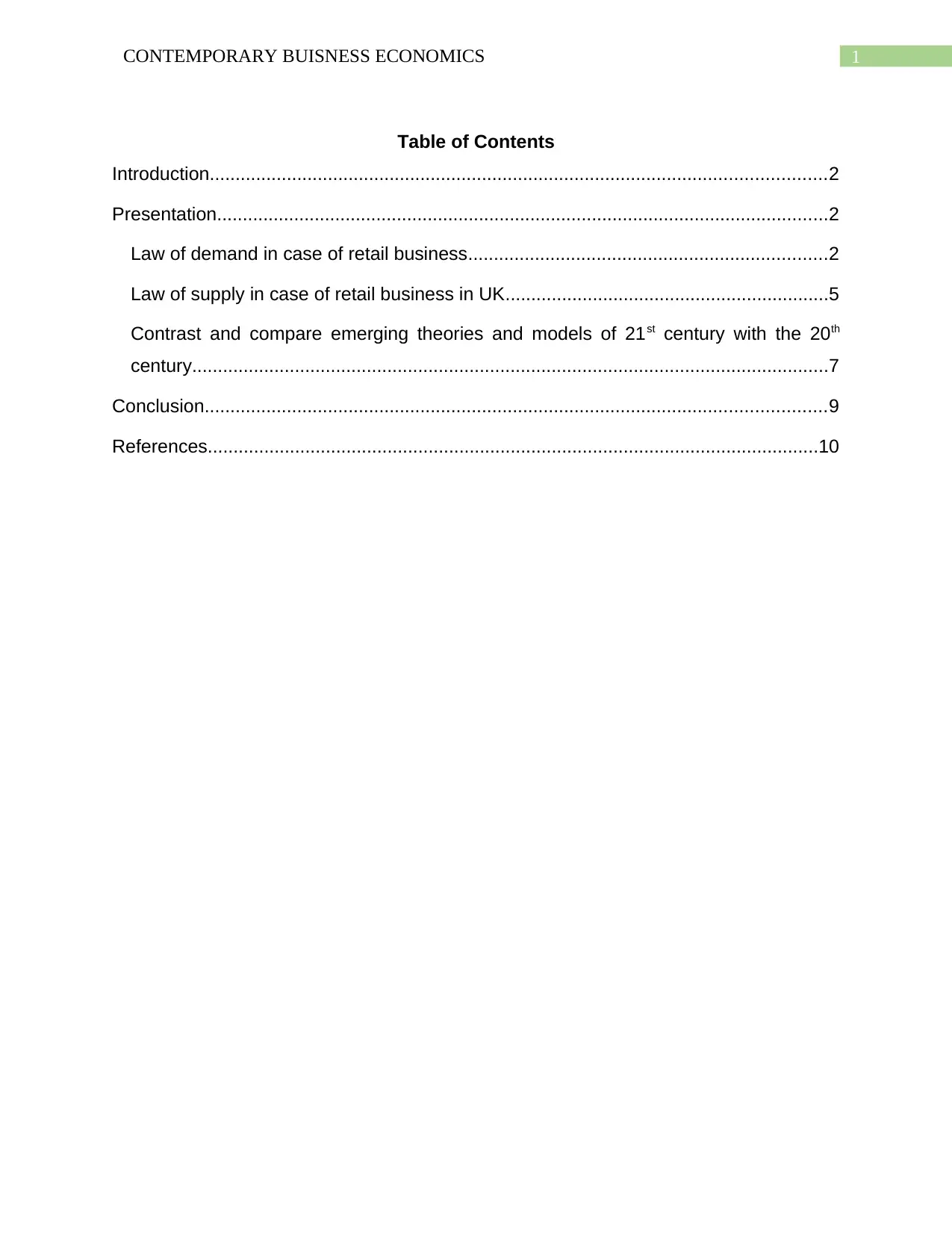
1CONTEMPORARY BUISNESS ECONOMICS
Table of Contents
Introduction........................................................................................................................2
Presentation.......................................................................................................................2
Law of demand in case of retail business......................................................................2
Law of supply in case of retail business in UK...............................................................5
Contrast and compare emerging theories and models of 21st century with the 20th
century............................................................................................................................7
Conclusion.........................................................................................................................9
References.......................................................................................................................10
Table of Contents
Introduction........................................................................................................................2
Presentation.......................................................................................................................2
Law of demand in case of retail business......................................................................2
Law of supply in case of retail business in UK...............................................................5
Contrast and compare emerging theories and models of 21st century with the 20th
century............................................................................................................................7
Conclusion.........................................................................................................................9
References.......................................................................................................................10
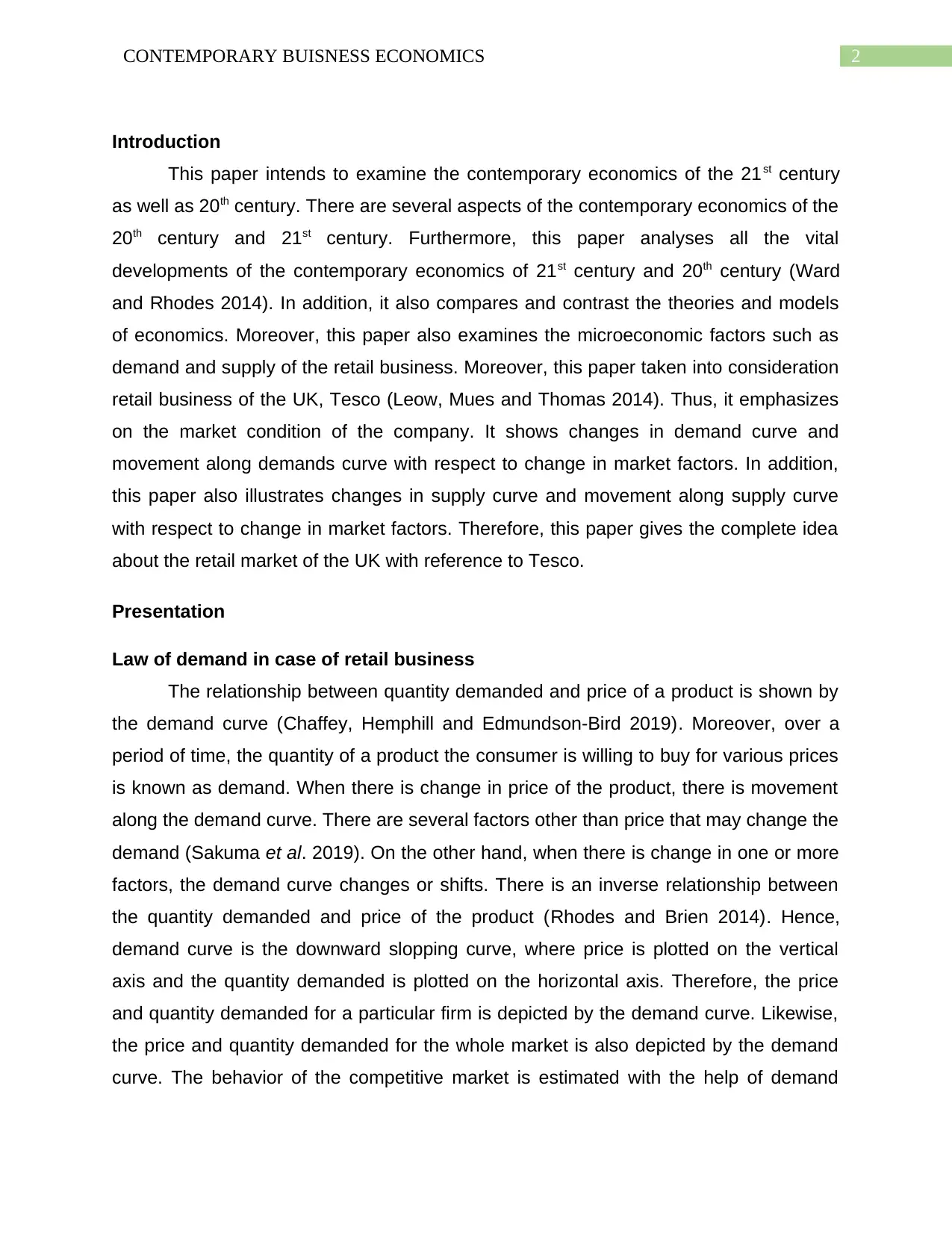
2CONTEMPORARY BUISNESS ECONOMICS
Introduction
This paper intends to examine the contemporary economics of the 21st century
as well as 20th century. There are several aspects of the contemporary economics of the
20th century and 21st century. Furthermore, this paper analyses all the vital
developments of the contemporary economics of 21st century and 20th century (Ward
and Rhodes 2014). In addition, it also compares and contrast the theories and models
of economics. Moreover, this paper also examines the microeconomic factors such as
demand and supply of the retail business. Moreover, this paper taken into consideration
retail business of the UK, Tesco (Leow, Mues and Thomas 2014). Thus, it emphasizes
on the market condition of the company. It shows changes in demand curve and
movement along demands curve with respect to change in market factors. In addition,
this paper also illustrates changes in supply curve and movement along supply curve
with respect to change in market factors. Therefore, this paper gives the complete idea
about the retail market of the UK with reference to Tesco.
Presentation
Law of demand in case of retail business
The relationship between quantity demanded and price of a product is shown by
the demand curve (Chaffey, Hemphill and Edmundson-Bird 2019). Moreover, over a
period of time, the quantity of a product the consumer is willing to buy for various prices
is known as demand. When there is change in price of the product, there is movement
along the demand curve. There are several factors other than price that may change the
demand (Sakuma et al. 2019). On the other hand, when there is change in one or more
factors, the demand curve changes or shifts. There is an inverse relationship between
the quantity demanded and price of the product (Rhodes and Brien 2014). Hence,
demand curve is the downward slopping curve, where price is plotted on the vertical
axis and the quantity demanded is plotted on the horizontal axis. Therefore, the price
and quantity demanded for a particular firm is depicted by the demand curve. Likewise,
the price and quantity demanded for the whole market is also depicted by the demand
curve. The behavior of the competitive market is estimated with the help of demand
Introduction
This paper intends to examine the contemporary economics of the 21st century
as well as 20th century. There are several aspects of the contemporary economics of the
20th century and 21st century. Furthermore, this paper analyses all the vital
developments of the contemporary economics of 21st century and 20th century (Ward
and Rhodes 2014). In addition, it also compares and contrast the theories and models
of economics. Moreover, this paper also examines the microeconomic factors such as
demand and supply of the retail business. Moreover, this paper taken into consideration
retail business of the UK, Tesco (Leow, Mues and Thomas 2014). Thus, it emphasizes
on the market condition of the company. It shows changes in demand curve and
movement along demands curve with respect to change in market factors. In addition,
this paper also illustrates changes in supply curve and movement along supply curve
with respect to change in market factors. Therefore, this paper gives the complete idea
about the retail market of the UK with reference to Tesco.
Presentation
Law of demand in case of retail business
The relationship between quantity demanded and price of a product is shown by
the demand curve (Chaffey, Hemphill and Edmundson-Bird 2019). Moreover, over a
period of time, the quantity of a product the consumer is willing to buy for various prices
is known as demand. When there is change in price of the product, there is movement
along the demand curve. There are several factors other than price that may change the
demand (Sakuma et al. 2019). On the other hand, when there is change in one or more
factors, the demand curve changes or shifts. There is an inverse relationship between
the quantity demanded and price of the product (Rhodes and Brien 2014). Hence,
demand curve is the downward slopping curve, where price is plotted on the vertical
axis and the quantity demanded is plotted on the horizontal axis. Therefore, the price
and quantity demanded for a particular firm is depicted by the demand curve. Likewise,
the price and quantity demanded for the whole market is also depicted by the demand
curve. The behavior of the competitive market is estimated with the help of demand
⊘ This is a preview!⊘
Do you want full access?
Subscribe today to unlock all pages.

Trusted by 1+ million students worldwide
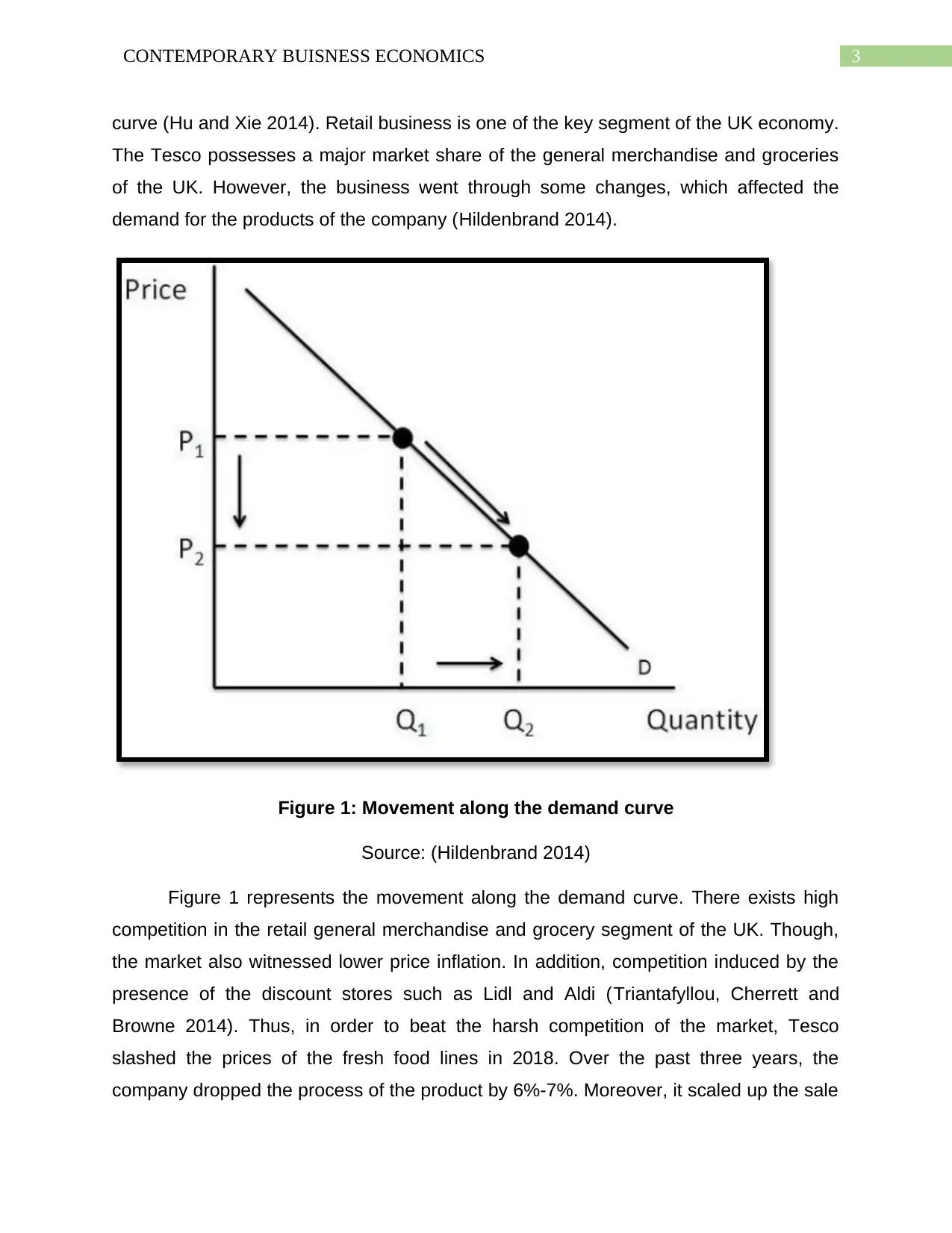
3CONTEMPORARY BUISNESS ECONOMICS
curve (Hu and Xie 2014). Retail business is one of the key segment of the UK economy.
The Tesco possesses a major market share of the general merchandise and groceries
of the UK. However, the business went through some changes, which affected the
demand for the products of the company (Hildenbrand 2014).
Figure 1: Movement along the demand curve
Source: (Hildenbrand 2014)
Figure 1 represents the movement along the demand curve. There exists high
competition in the retail general merchandise and grocery segment of the UK. Though,
the market also witnessed lower price inflation. In addition, competition induced by the
presence of the discount stores such as Lidl and Aldi (Triantafyllou, Cherrett and
Browne 2014). Thus, in order to beat the harsh competition of the market, Tesco
slashed the prices of the fresh food lines in 2018. Over the past three years, the
company dropped the process of the product by 6%-7%. Moreover, it scaled up the sale
curve (Hu and Xie 2014). Retail business is one of the key segment of the UK economy.
The Tesco possesses a major market share of the general merchandise and groceries
of the UK. However, the business went through some changes, which affected the
demand for the products of the company (Hildenbrand 2014).
Figure 1: Movement along the demand curve
Source: (Hildenbrand 2014)
Figure 1 represents the movement along the demand curve. There exists high
competition in the retail general merchandise and grocery segment of the UK. Though,
the market also witnessed lower price inflation. In addition, competition induced by the
presence of the discount stores such as Lidl and Aldi (Triantafyllou, Cherrett and
Browne 2014). Thus, in order to beat the harsh competition of the market, Tesco
slashed the prices of the fresh food lines in 2018. Over the past three years, the
company dropped the process of the product by 6%-7%. Moreover, it scaled up the sale
Paraphrase This Document
Need a fresh take? Get an instant paraphrase of this document with our AI Paraphraser
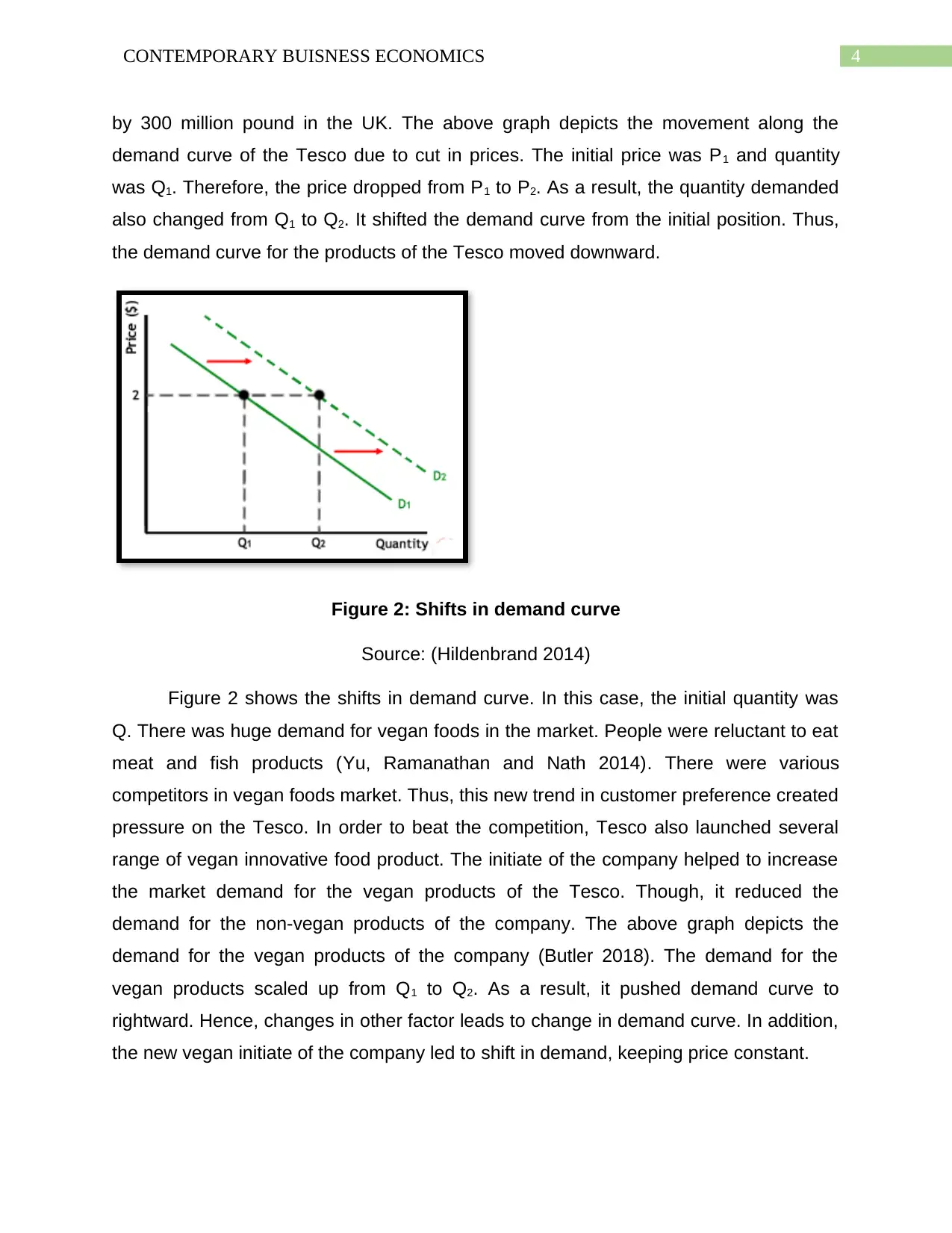
4CONTEMPORARY BUISNESS ECONOMICS
by 300 million pound in the UK. The above graph depicts the movement along the
demand curve of the Tesco due to cut in prices. The initial price was P1 and quantity
was Q1. Therefore, the price dropped from P1 to P2. As a result, the quantity demanded
also changed from Q1 to Q2. It shifted the demand curve from the initial position. Thus,
the demand curve for the products of the Tesco moved downward.
Figure 2: Shifts in demand curve
Source: (Hildenbrand 2014)
Figure 2 shows the shifts in demand curve. In this case, the initial quantity was
Q. There was huge demand for vegan foods in the market. People were reluctant to eat
meat and fish products (Yu, Ramanathan and Nath 2014). There were various
competitors in vegan foods market. Thus, this new trend in customer preference created
pressure on the Tesco. In order to beat the competition, Tesco also launched several
range of vegan innovative food product. The initiate of the company helped to increase
the market demand for the vegan products of the Tesco. Though, it reduced the
demand for the non-vegan products of the company. The above graph depicts the
demand for the vegan products of the company (Butler 2018). The demand for the
vegan products scaled up from Q1 to Q2. As a result, it pushed demand curve to
rightward. Hence, changes in other factor leads to change in demand curve. In addition,
the new vegan initiate of the company led to shift in demand, keeping price constant.
by 300 million pound in the UK. The above graph depicts the movement along the
demand curve of the Tesco due to cut in prices. The initial price was P1 and quantity
was Q1. Therefore, the price dropped from P1 to P2. As a result, the quantity demanded
also changed from Q1 to Q2. It shifted the demand curve from the initial position. Thus,
the demand curve for the products of the Tesco moved downward.
Figure 2: Shifts in demand curve
Source: (Hildenbrand 2014)
Figure 2 shows the shifts in demand curve. In this case, the initial quantity was
Q. There was huge demand for vegan foods in the market. People were reluctant to eat
meat and fish products (Yu, Ramanathan and Nath 2014). There were various
competitors in vegan foods market. Thus, this new trend in customer preference created
pressure on the Tesco. In order to beat the competition, Tesco also launched several
range of vegan innovative food product. The initiate of the company helped to increase
the market demand for the vegan products of the Tesco. Though, it reduced the
demand for the non-vegan products of the company. The above graph depicts the
demand for the vegan products of the company (Butler 2018). The demand for the
vegan products scaled up from Q1 to Q2. As a result, it pushed demand curve to
rightward. Hence, changes in other factor leads to change in demand curve. In addition,
the new vegan initiate of the company led to shift in demand, keeping price constant.
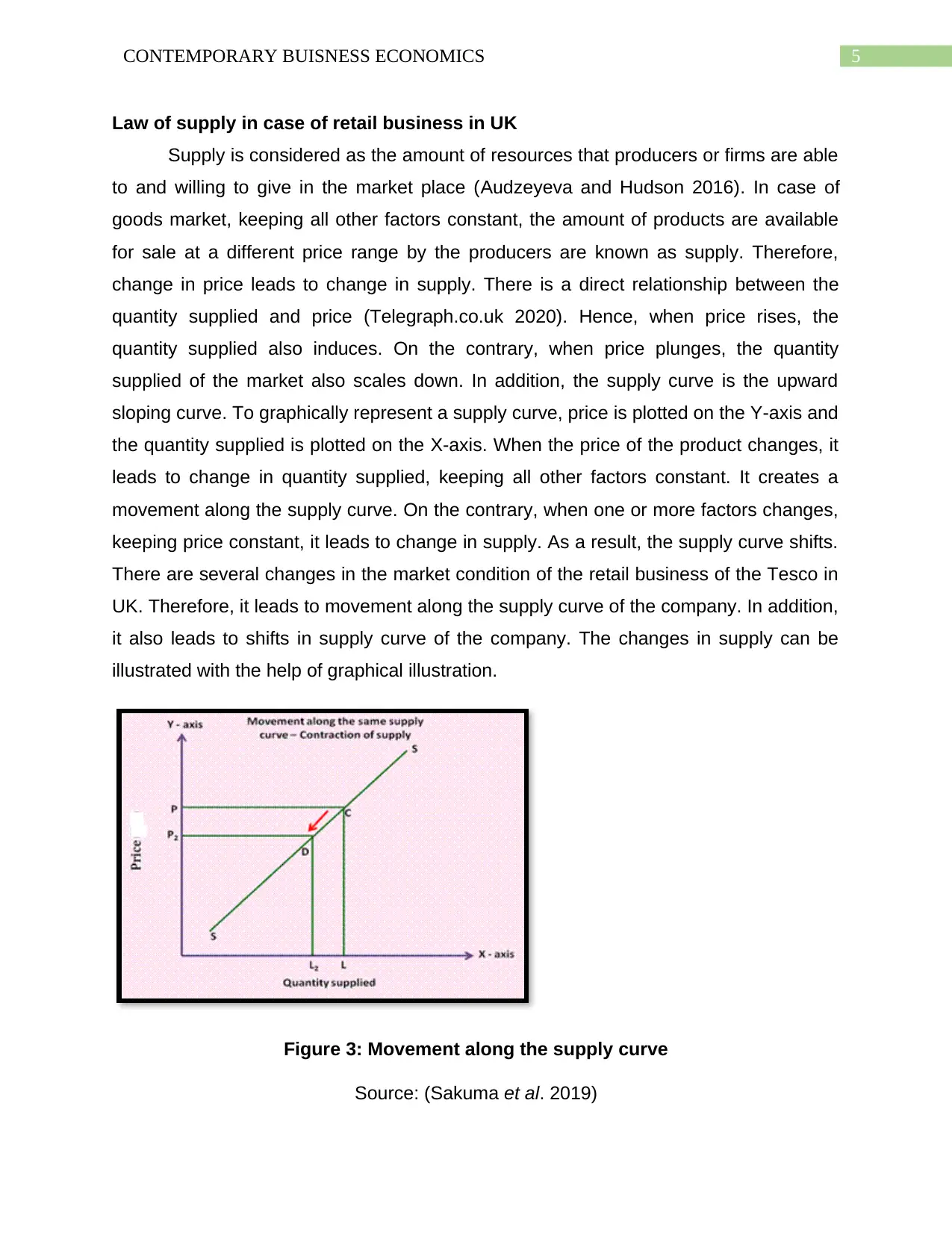
5CONTEMPORARY BUISNESS ECONOMICS
Law of supply in case of retail business in UK
Supply is considered as the amount of resources that producers or firms are able
to and willing to give in the market place (Audzeyeva and Hudson 2016). In case of
goods market, keeping all other factors constant, the amount of products are available
for sale at a different price range by the producers are known as supply. Therefore,
change in price leads to change in supply. There is a direct relationship between the
quantity supplied and price (Telegraph.co.uk 2020). Hence, when price rises, the
quantity supplied also induces. On the contrary, when price plunges, the quantity
supplied of the market also scales down. In addition, the supply curve is the upward
sloping curve. To graphically represent a supply curve, price is plotted on the Y-axis and
the quantity supplied is plotted on the X-axis. When the price of the product changes, it
leads to change in quantity supplied, keeping all other factors constant. It creates a
movement along the supply curve. On the contrary, when one or more factors changes,
keeping price constant, it leads to change in supply. As a result, the supply curve shifts.
There are several changes in the market condition of the retail business of the Tesco in
UK. Therefore, it leads to movement along the supply curve of the company. In addition,
it also leads to shifts in supply curve of the company. The changes in supply can be
illustrated with the help of graphical illustration.
Figure 3: Movement along the supply curve
Source: (Sakuma et al. 2019)
Law of supply in case of retail business in UK
Supply is considered as the amount of resources that producers or firms are able
to and willing to give in the market place (Audzeyeva and Hudson 2016). In case of
goods market, keeping all other factors constant, the amount of products are available
for sale at a different price range by the producers are known as supply. Therefore,
change in price leads to change in supply. There is a direct relationship between the
quantity supplied and price (Telegraph.co.uk 2020). Hence, when price rises, the
quantity supplied also induces. On the contrary, when price plunges, the quantity
supplied of the market also scales down. In addition, the supply curve is the upward
sloping curve. To graphically represent a supply curve, price is plotted on the Y-axis and
the quantity supplied is plotted on the X-axis. When the price of the product changes, it
leads to change in quantity supplied, keeping all other factors constant. It creates a
movement along the supply curve. On the contrary, when one or more factors changes,
keeping price constant, it leads to change in supply. As a result, the supply curve shifts.
There are several changes in the market condition of the retail business of the Tesco in
UK. Therefore, it leads to movement along the supply curve of the company. In addition,
it also leads to shifts in supply curve of the company. The changes in supply can be
illustrated with the help of graphical illustration.
Figure 3: Movement along the supply curve
Source: (Sakuma et al. 2019)
⊘ This is a preview!⊘
Do you want full access?
Subscribe today to unlock all pages.

Trusted by 1+ million students worldwide
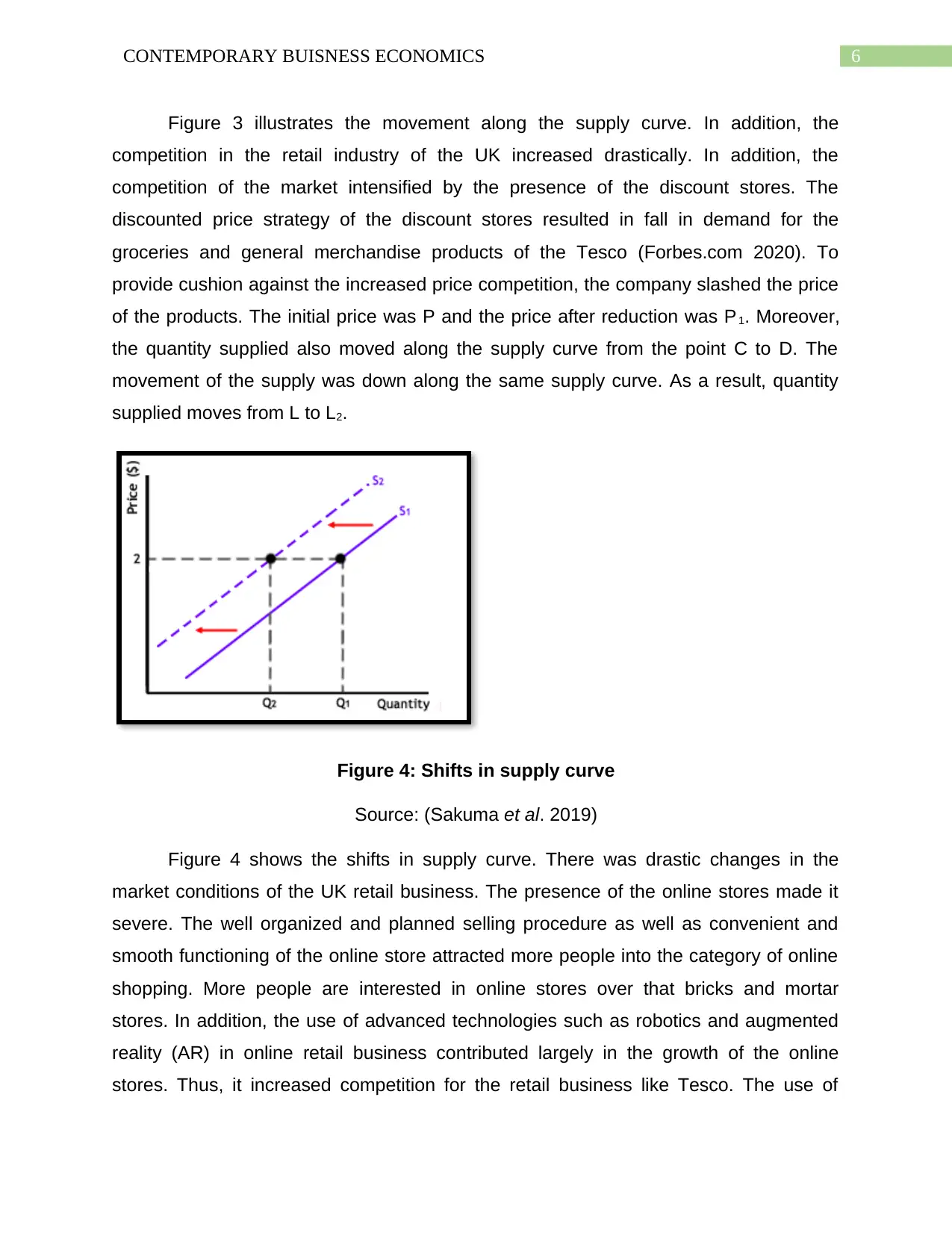
6CONTEMPORARY BUISNESS ECONOMICS
Figure 3 illustrates the movement along the supply curve. In addition, the
competition in the retail industry of the UK increased drastically. In addition, the
competition of the market intensified by the presence of the discount stores. The
discounted price strategy of the discount stores resulted in fall in demand for the
groceries and general merchandise products of the Tesco (Forbes.com 2020). To
provide cushion against the increased price competition, the company slashed the price
of the products. The initial price was P and the price after reduction was P 1. Moreover,
the quantity supplied also moved along the supply curve from the point C to D. The
movement of the supply was down along the same supply curve. As a result, quantity
supplied moves from L to L2.
Figure 4: Shifts in supply curve
Source: (Sakuma et al. 2019)
Figure 4 shows the shifts in supply curve. There was drastic changes in the
market conditions of the UK retail business. The presence of the online stores made it
severe. The well organized and planned selling procedure as well as convenient and
smooth functioning of the online store attracted more people into the category of online
shopping. More people are interested in online stores over that bricks and mortar
stores. In addition, the use of advanced technologies such as robotics and augmented
reality (AR) in online retail business contributed largely in the growth of the online
stores. Thus, it increased competition for the retail business like Tesco. The use of
Figure 3 illustrates the movement along the supply curve. In addition, the
competition in the retail industry of the UK increased drastically. In addition, the
competition of the market intensified by the presence of the discount stores. The
discounted price strategy of the discount stores resulted in fall in demand for the
groceries and general merchandise products of the Tesco (Forbes.com 2020). To
provide cushion against the increased price competition, the company slashed the price
of the products. The initial price was P and the price after reduction was P 1. Moreover,
the quantity supplied also moved along the supply curve from the point C to D. The
movement of the supply was down along the same supply curve. As a result, quantity
supplied moves from L to L2.
Figure 4: Shifts in supply curve
Source: (Sakuma et al. 2019)
Figure 4 shows the shifts in supply curve. There was drastic changes in the
market conditions of the UK retail business. The presence of the online stores made it
severe. The well organized and planned selling procedure as well as convenient and
smooth functioning of the online store attracted more people into the category of online
shopping. More people are interested in online stores over that bricks and mortar
stores. In addition, the use of advanced technologies such as robotics and augmented
reality (AR) in online retail business contributed largely in the growth of the online
stores. Thus, it increased competition for the retail business like Tesco. The use of
Paraphrase This Document
Need a fresh take? Get an instant paraphrase of this document with our AI Paraphraser
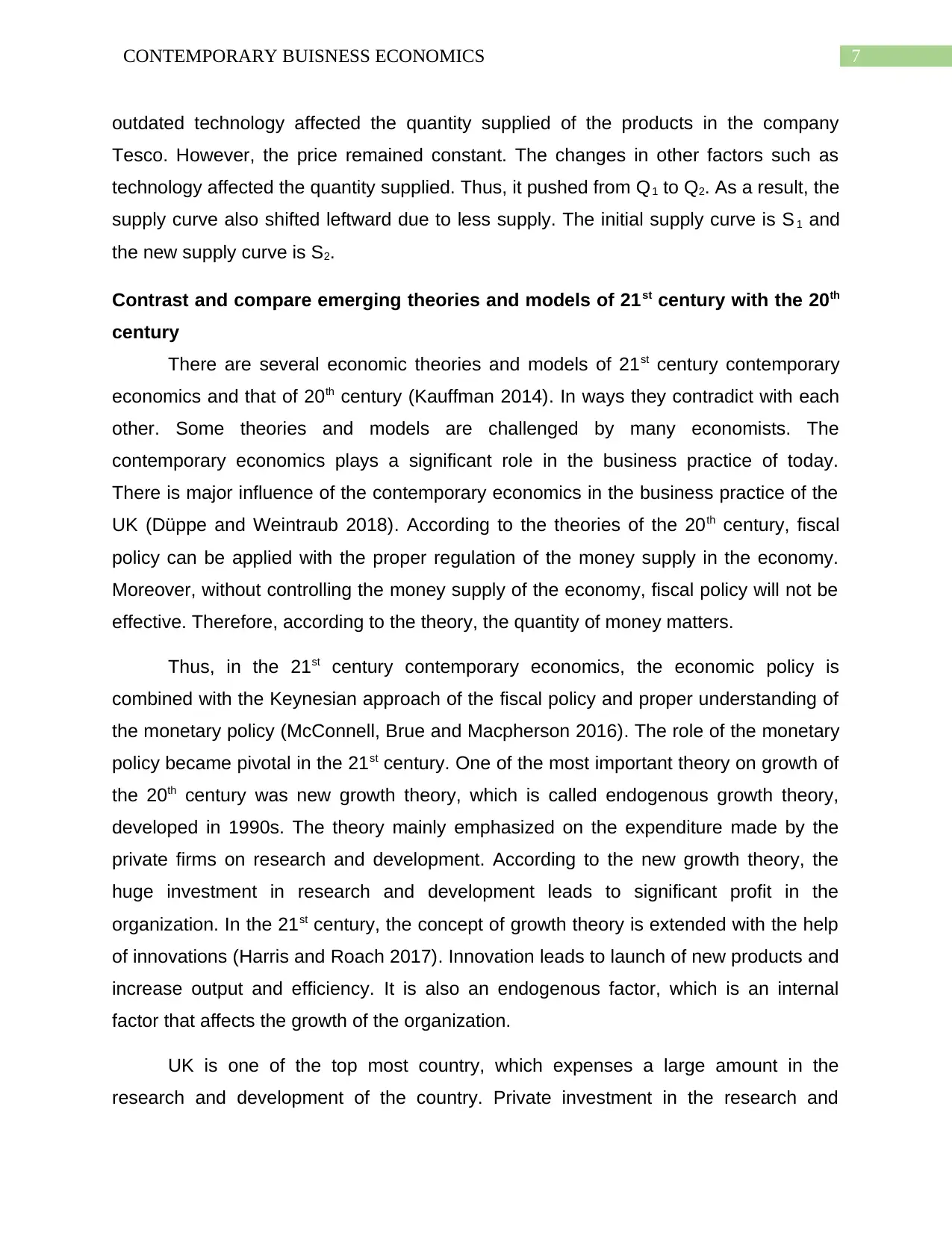
7CONTEMPORARY BUISNESS ECONOMICS
outdated technology affected the quantity supplied of the products in the company
Tesco. However, the price remained constant. The changes in other factors such as
technology affected the quantity supplied. Thus, it pushed from Q1 to Q2. As a result, the
supply curve also shifted leftward due to less supply. The initial supply curve is S 1 and
the new supply curve is S2.
Contrast and compare emerging theories and models of 21st century with the 20th
century
There are several economic theories and models of 21st century contemporary
economics and that of 20th century (Kauffman 2014). In ways they contradict with each
other. Some theories and models are challenged by many economists. The
contemporary economics plays a significant role in the business practice of today.
There is major influence of the contemporary economics in the business practice of the
UK (Düppe and Weintraub 2018). According to the theories of the 20th century, fiscal
policy can be applied with the proper regulation of the money supply in the economy.
Moreover, without controlling the money supply of the economy, fiscal policy will not be
effective. Therefore, according to the theory, the quantity of money matters.
Thus, in the 21st century contemporary economics, the economic policy is
combined with the Keynesian approach of the fiscal policy and proper understanding of
the monetary policy (McConnell, Brue and Macpherson 2016). The role of the monetary
policy became pivotal in the 21st century. One of the most important theory on growth of
the 20th century was new growth theory, which is called endogenous growth theory,
developed in 1990s. The theory mainly emphasized on the expenditure made by the
private firms on research and development. According to the new growth theory, the
huge investment in research and development leads to significant profit in the
organization. In the 21st century, the concept of growth theory is extended with the help
of innovations (Harris and Roach 2017). Innovation leads to launch of new products and
increase output and efficiency. It is also an endogenous factor, which is an internal
factor that affects the growth of the organization.
UK is one of the top most country, which expenses a large amount in the
research and development of the country. Private investment in the research and
outdated technology affected the quantity supplied of the products in the company
Tesco. However, the price remained constant. The changes in other factors such as
technology affected the quantity supplied. Thus, it pushed from Q1 to Q2. As a result, the
supply curve also shifted leftward due to less supply. The initial supply curve is S 1 and
the new supply curve is S2.
Contrast and compare emerging theories and models of 21st century with the 20th
century
There are several economic theories and models of 21st century contemporary
economics and that of 20th century (Kauffman 2014). In ways they contradict with each
other. Some theories and models are challenged by many economists. The
contemporary economics plays a significant role in the business practice of today.
There is major influence of the contemporary economics in the business practice of the
UK (Düppe and Weintraub 2018). According to the theories of the 20th century, fiscal
policy can be applied with the proper regulation of the money supply in the economy.
Moreover, without controlling the money supply of the economy, fiscal policy will not be
effective. Therefore, according to the theory, the quantity of money matters.
Thus, in the 21st century contemporary economics, the economic policy is
combined with the Keynesian approach of the fiscal policy and proper understanding of
the monetary policy (McConnell, Brue and Macpherson 2016). The role of the monetary
policy became pivotal in the 21st century. One of the most important theory on growth of
the 20th century was new growth theory, which is called endogenous growth theory,
developed in 1990s. The theory mainly emphasized on the expenditure made by the
private firms on research and development. According to the new growth theory, the
huge investment in research and development leads to significant profit in the
organization. In the 21st century, the concept of growth theory is extended with the help
of innovations (Harris and Roach 2017). Innovation leads to launch of new products and
increase output and efficiency. It is also an endogenous factor, which is an internal
factor that affects the growth of the organization.
UK is one of the top most country, which expenses a large amount in the
research and development of the country. Private investment in the research and
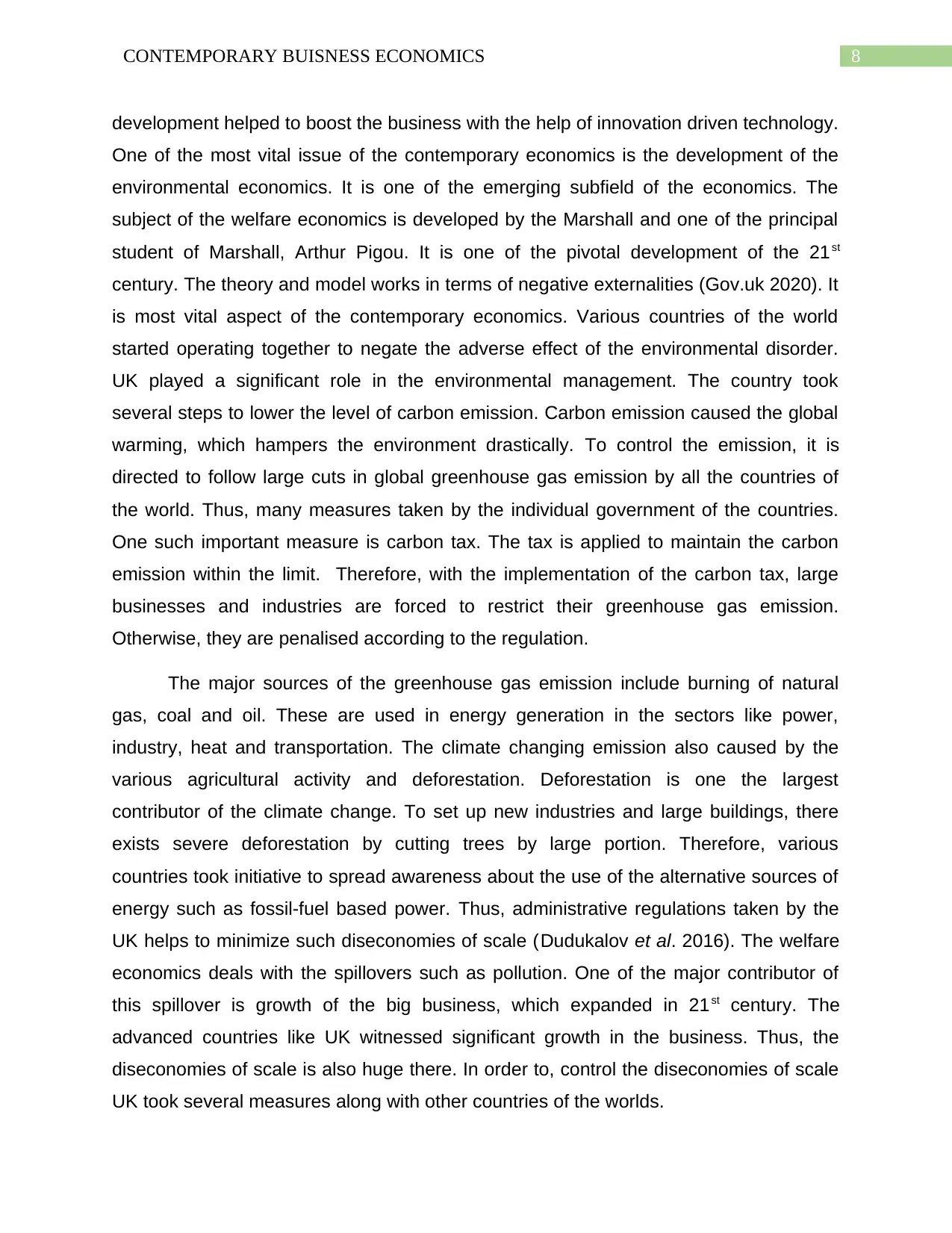
8CONTEMPORARY BUISNESS ECONOMICS
development helped to boost the business with the help of innovation driven technology.
One of the most vital issue of the contemporary economics is the development of the
environmental economics. It is one of the emerging subfield of the economics. The
subject of the welfare economics is developed by the Marshall and one of the principal
student of Marshall, Arthur Pigou. It is one of the pivotal development of the 21st
century. The theory and model works in terms of negative externalities (Gov.uk 2020). It
is most vital aspect of the contemporary economics. Various countries of the world
started operating together to negate the adverse effect of the environmental disorder.
UK played a significant role in the environmental management. The country took
several steps to lower the level of carbon emission. Carbon emission caused the global
warming, which hampers the environment drastically. To control the emission, it is
directed to follow large cuts in global greenhouse gas emission by all the countries of
the world. Thus, many measures taken by the individual government of the countries.
One such important measure is carbon tax. The tax is applied to maintain the carbon
emission within the limit. Therefore, with the implementation of the carbon tax, large
businesses and industries are forced to restrict their greenhouse gas emission.
Otherwise, they are penalised according to the regulation.
The major sources of the greenhouse gas emission include burning of natural
gas, coal and oil. These are used in energy generation in the sectors like power,
industry, heat and transportation. The climate changing emission also caused by the
various agricultural activity and deforestation. Deforestation is one the largest
contributor of the climate change. To set up new industries and large buildings, there
exists severe deforestation by cutting trees by large portion. Therefore, various
countries took initiative to spread awareness about the use of the alternative sources of
energy such as fossil-fuel based power. Thus, administrative regulations taken by the
UK helps to minimize such diseconomies of scale (Dudukalov et al. 2016). The welfare
economics deals with the spillovers such as pollution. One of the major contributor of
this spillover is growth of the big business, which expanded in 21st century. The
advanced countries like UK witnessed significant growth in the business. Thus, the
diseconomies of scale is also huge there. In order to, control the diseconomies of scale
UK took several measures along with other countries of the worlds.
development helped to boost the business with the help of innovation driven technology.
One of the most vital issue of the contemporary economics is the development of the
environmental economics. It is one of the emerging subfield of the economics. The
subject of the welfare economics is developed by the Marshall and one of the principal
student of Marshall, Arthur Pigou. It is one of the pivotal development of the 21st
century. The theory and model works in terms of negative externalities (Gov.uk 2020). It
is most vital aspect of the contemporary economics. Various countries of the world
started operating together to negate the adverse effect of the environmental disorder.
UK played a significant role in the environmental management. The country took
several steps to lower the level of carbon emission. Carbon emission caused the global
warming, which hampers the environment drastically. To control the emission, it is
directed to follow large cuts in global greenhouse gas emission by all the countries of
the world. Thus, many measures taken by the individual government of the countries.
One such important measure is carbon tax. The tax is applied to maintain the carbon
emission within the limit. Therefore, with the implementation of the carbon tax, large
businesses and industries are forced to restrict their greenhouse gas emission.
Otherwise, they are penalised according to the regulation.
The major sources of the greenhouse gas emission include burning of natural
gas, coal and oil. These are used in energy generation in the sectors like power,
industry, heat and transportation. The climate changing emission also caused by the
various agricultural activity and deforestation. Deforestation is one the largest
contributor of the climate change. To set up new industries and large buildings, there
exists severe deforestation by cutting trees by large portion. Therefore, various
countries took initiative to spread awareness about the use of the alternative sources of
energy such as fossil-fuel based power. Thus, administrative regulations taken by the
UK helps to minimize such diseconomies of scale (Dudukalov et al. 2016). The welfare
economics deals with the spillovers such as pollution. One of the major contributor of
this spillover is growth of the big business, which expanded in 21st century. The
advanced countries like UK witnessed significant growth in the business. Thus, the
diseconomies of scale is also huge there. In order to, control the diseconomies of scale
UK took several measures along with other countries of the worlds.
⊘ This is a preview!⊘
Do you want full access?
Subscribe today to unlock all pages.

Trusted by 1+ million students worldwide
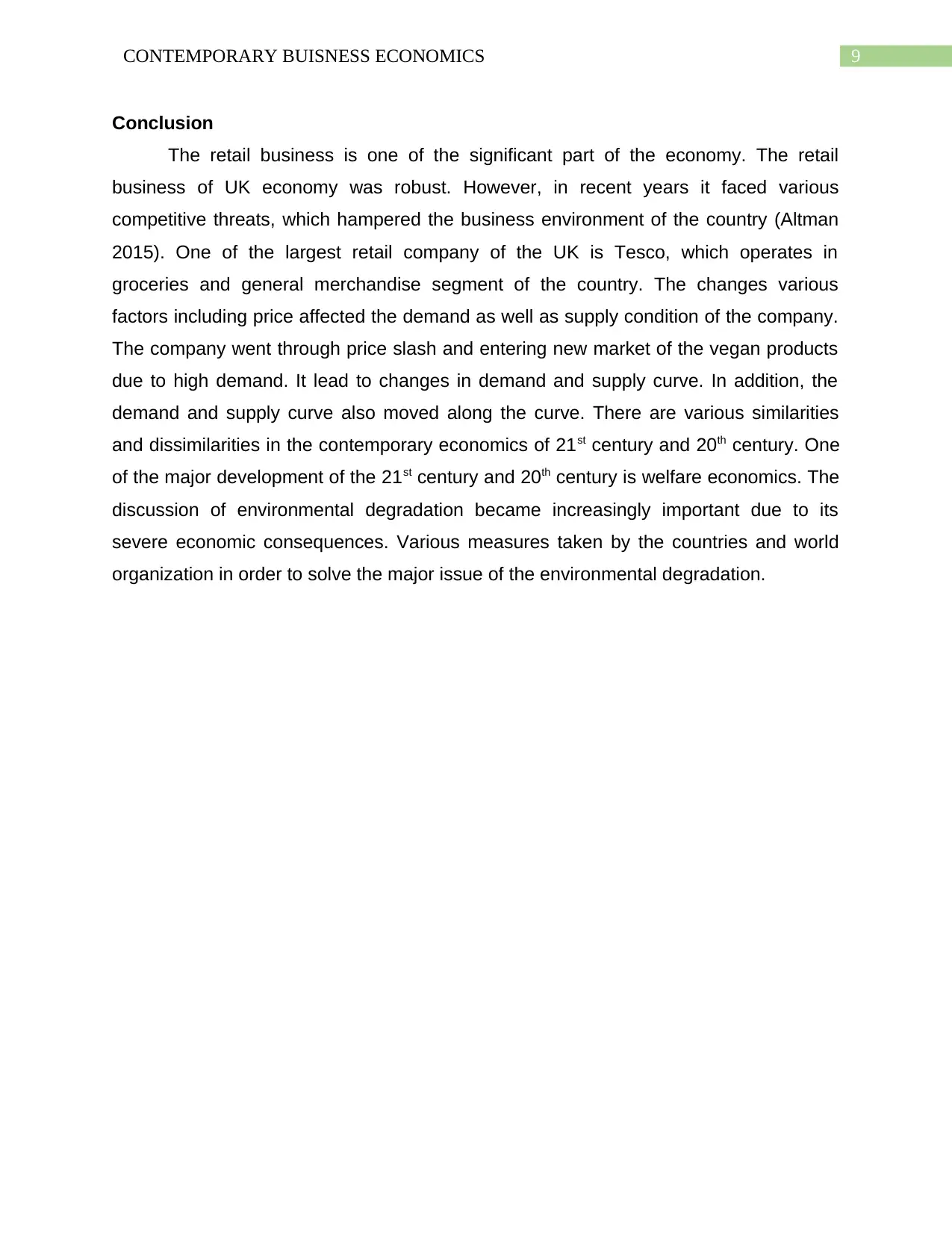
9CONTEMPORARY BUISNESS ECONOMICS
Conclusion
The retail business is one of the significant part of the economy. The retail
business of UK economy was robust. However, in recent years it faced various
competitive threats, which hampered the business environment of the country (Altman
2015). One of the largest retail company of the UK is Tesco, which operates in
groceries and general merchandise segment of the country. The changes various
factors including price affected the demand as well as supply condition of the company.
The company went through price slash and entering new market of the vegan products
due to high demand. It lead to changes in demand and supply curve. In addition, the
demand and supply curve also moved along the curve. There are various similarities
and dissimilarities in the contemporary economics of 21st century and 20th century. One
of the major development of the 21st century and 20th century is welfare economics. The
discussion of environmental degradation became increasingly important due to its
severe economic consequences. Various measures taken by the countries and world
organization in order to solve the major issue of the environmental degradation.
Conclusion
The retail business is one of the significant part of the economy. The retail
business of UK economy was robust. However, in recent years it faced various
competitive threats, which hampered the business environment of the country (Altman
2015). One of the largest retail company of the UK is Tesco, which operates in
groceries and general merchandise segment of the country. The changes various
factors including price affected the demand as well as supply condition of the company.
The company went through price slash and entering new market of the vegan products
due to high demand. It lead to changes in demand and supply curve. In addition, the
demand and supply curve also moved along the curve. There are various similarities
and dissimilarities in the contemporary economics of 21st century and 20th century. One
of the major development of the 21st century and 20th century is welfare economics. The
discussion of environmental degradation became increasingly important due to its
severe economic consequences. Various measures taken by the countries and world
organization in order to solve the major issue of the environmental degradation.
Paraphrase This Document
Need a fresh take? Get an instant paraphrase of this document with our AI Paraphraser
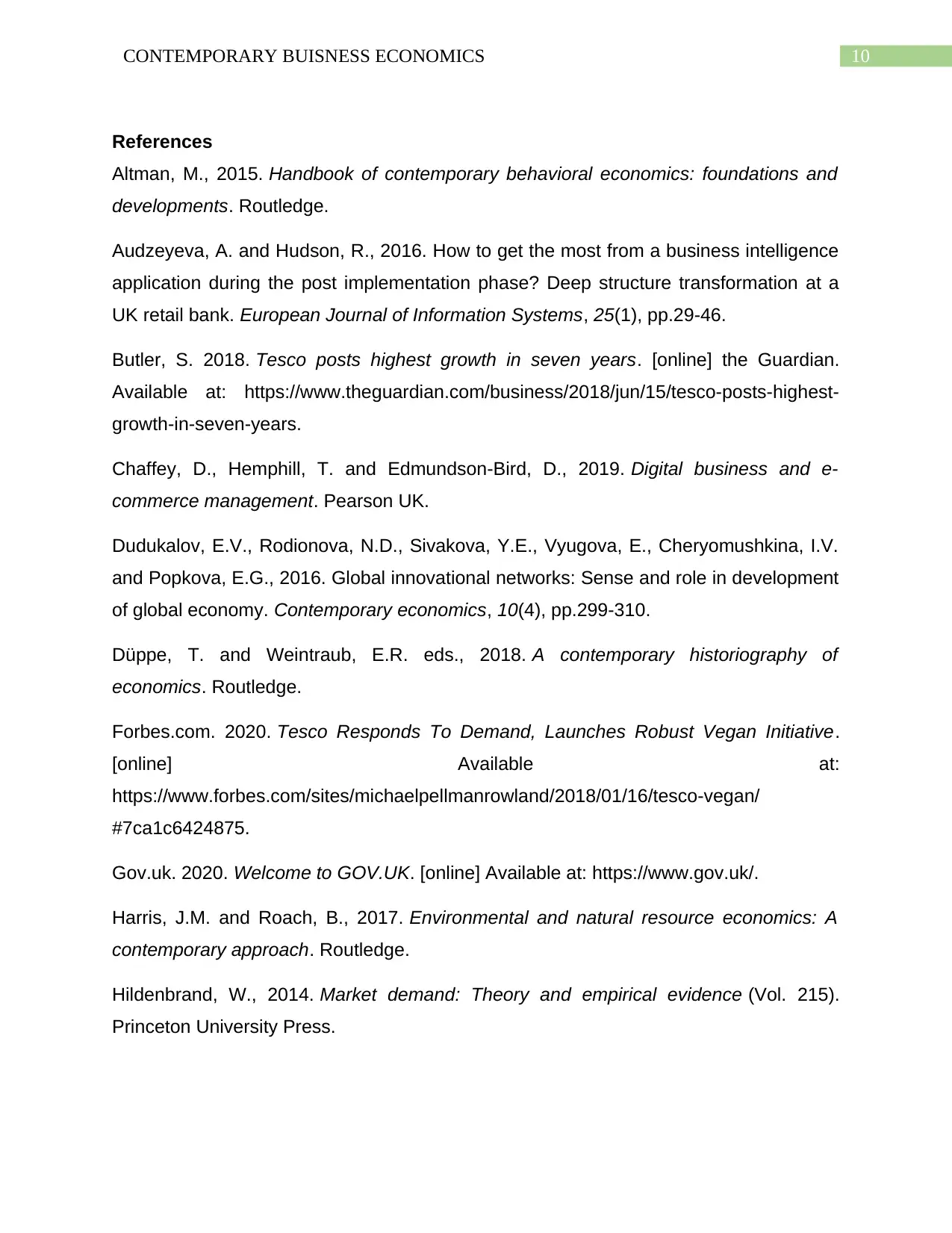
10CONTEMPORARY BUISNESS ECONOMICS
References
Altman, M., 2015. Handbook of contemporary behavioral economics: foundations and
developments. Routledge.
Audzeyeva, A. and Hudson, R., 2016. How to get the most from a business intelligence
application during the post implementation phase? Deep structure transformation at a
UK retail bank. European Journal of Information Systems, 25(1), pp.29-46.
Butler, S. 2018. Tesco posts highest growth in seven years. [online] the Guardian.
Available at: https://www.theguardian.com/business/2018/jun/15/tesco-posts-highest-
growth-in-seven-years.
Chaffey, D., Hemphill, T. and Edmundson-Bird, D., 2019. Digital business and e-
commerce management. Pearson UK.
Dudukalov, E.V., Rodionova, N.D., Sivakova, Y.E., Vyugova, E., Cheryomushkina, I.V.
and Popkova, E.G., 2016. Global innovational networks: Sense and role in development
of global economy. Contemporary economics, 10(4), pp.299-310.
Düppe, T. and Weintraub, E.R. eds., 2018. A contemporary historiography of
economics. Routledge.
Forbes.com. 2020. Tesco Responds To Demand, Launches Robust Vegan Initiative.
[online] Available at:
https://www.forbes.com/sites/michaelpellmanrowland/2018/01/16/tesco-vegan/
#7ca1c6424875.
Gov.uk. 2020. Welcome to GOV.UK. [online] Available at: https://www.gov.uk/.
Harris, J.M. and Roach, B., 2017. Environmental and natural resource economics: A
contemporary approach. Routledge.
Hildenbrand, W., 2014. Market demand: Theory and empirical evidence (Vol. 215).
Princeton University Press.
References
Altman, M., 2015. Handbook of contemporary behavioral economics: foundations and
developments. Routledge.
Audzeyeva, A. and Hudson, R., 2016. How to get the most from a business intelligence
application during the post implementation phase? Deep structure transformation at a
UK retail bank. European Journal of Information Systems, 25(1), pp.29-46.
Butler, S. 2018. Tesco posts highest growth in seven years. [online] the Guardian.
Available at: https://www.theguardian.com/business/2018/jun/15/tesco-posts-highest-
growth-in-seven-years.
Chaffey, D., Hemphill, T. and Edmundson-Bird, D., 2019. Digital business and e-
commerce management. Pearson UK.
Dudukalov, E.V., Rodionova, N.D., Sivakova, Y.E., Vyugova, E., Cheryomushkina, I.V.
and Popkova, E.G., 2016. Global innovational networks: Sense and role in development
of global economy. Contemporary economics, 10(4), pp.299-310.
Düppe, T. and Weintraub, E.R. eds., 2018. A contemporary historiography of
economics. Routledge.
Forbes.com. 2020. Tesco Responds To Demand, Launches Robust Vegan Initiative.
[online] Available at:
https://www.forbes.com/sites/michaelpellmanrowland/2018/01/16/tesco-vegan/
#7ca1c6424875.
Gov.uk. 2020. Welcome to GOV.UK. [online] Available at: https://www.gov.uk/.
Harris, J.M. and Roach, B., 2017. Environmental and natural resource economics: A
contemporary approach. Routledge.
Hildenbrand, W., 2014. Market demand: Theory and empirical evidence (Vol. 215).
Princeton University Press.
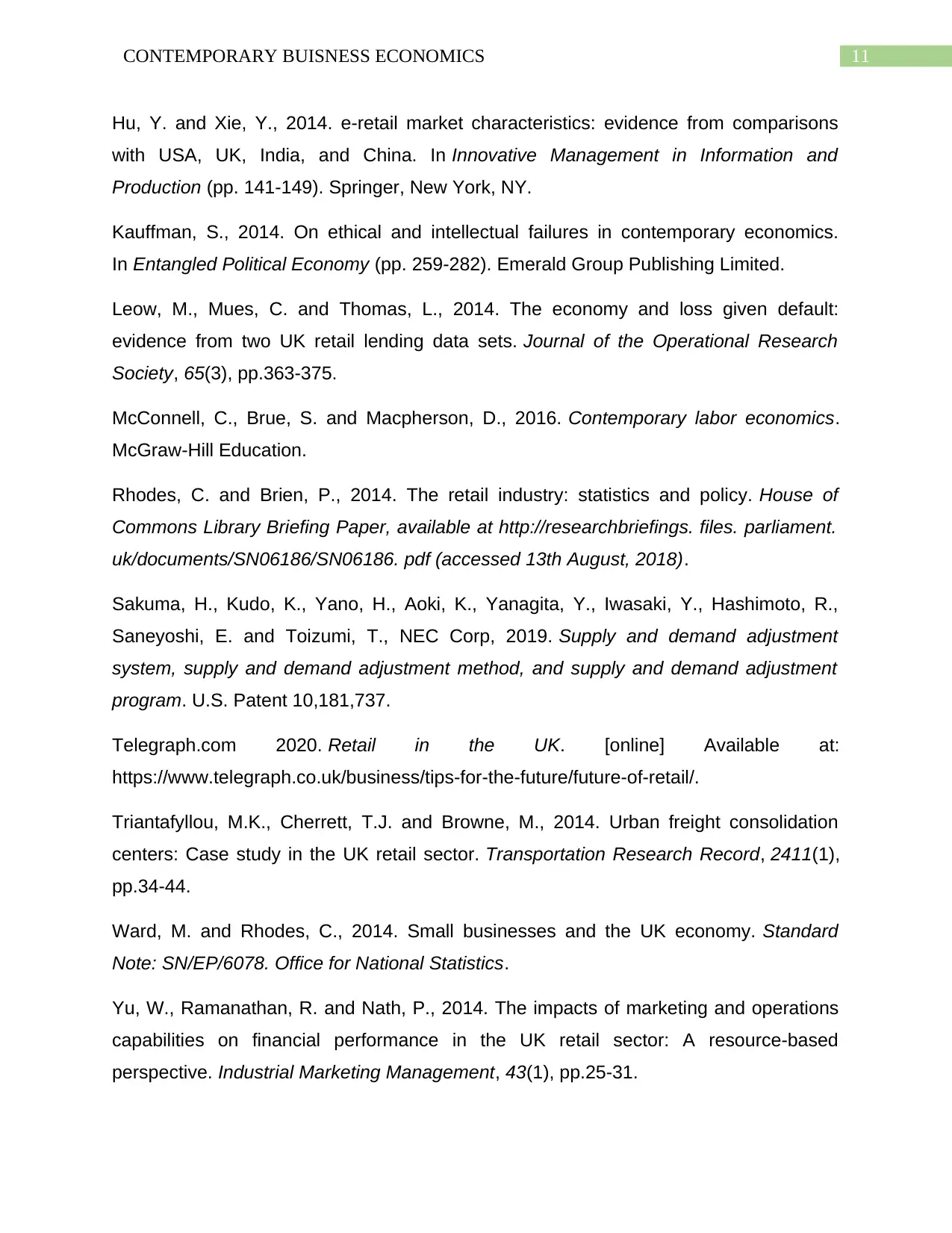
11CONTEMPORARY BUISNESS ECONOMICS
Hu, Y. and Xie, Y., 2014. e-retail market characteristics: evidence from comparisons
with USA, UK, India, and China. In Innovative Management in Information and
Production (pp. 141-149). Springer, New York, NY.
Kauffman, S., 2014. On ethical and intellectual failures in contemporary economics.
In Entangled Political Economy (pp. 259-282). Emerald Group Publishing Limited.
Leow, M., Mues, C. and Thomas, L., 2014. The economy and loss given default:
evidence from two UK retail lending data sets. Journal of the Operational Research
Society, 65(3), pp.363-375.
McConnell, C., Brue, S. and Macpherson, D., 2016. Contemporary labor economics.
McGraw-Hill Education.
Rhodes, C. and Brien, P., 2014. The retail industry: statistics and policy. House of
Commons Library Briefing Paper, available at http://researchbriefings. files. parliament.
uk/documents/SN06186/SN06186. pdf (accessed 13th August, 2018).
Sakuma, H., Kudo, K., Yano, H., Aoki, K., Yanagita, Y., Iwasaki, Y., Hashimoto, R.,
Saneyoshi, E. and Toizumi, T., NEC Corp, 2019. Supply and demand adjustment
system, supply and demand adjustment method, and supply and demand adjustment
program. U.S. Patent 10,181,737.
Telegraph.com 2020. Retail in the UK. [online] Available at:
https://www.telegraph.co.uk/business/tips-for-the-future/future-of-retail/.
Triantafyllou, M.K., Cherrett, T.J. and Browne, M., 2014. Urban freight consolidation
centers: Case study in the UK retail sector. Transportation Research Record, 2411(1),
pp.34-44.
Ward, M. and Rhodes, C., 2014. Small businesses and the UK economy. Standard
Note: SN/EP/6078. Office for National Statistics.
Yu, W., Ramanathan, R. and Nath, P., 2014. The impacts of marketing and operations
capabilities on financial performance in the UK retail sector: A resource-based
perspective. Industrial Marketing Management, 43(1), pp.25-31.
Hu, Y. and Xie, Y., 2014. e-retail market characteristics: evidence from comparisons
with USA, UK, India, and China. In Innovative Management in Information and
Production (pp. 141-149). Springer, New York, NY.
Kauffman, S., 2014. On ethical and intellectual failures in contemporary economics.
In Entangled Political Economy (pp. 259-282). Emerald Group Publishing Limited.
Leow, M., Mues, C. and Thomas, L., 2014. The economy and loss given default:
evidence from two UK retail lending data sets. Journal of the Operational Research
Society, 65(3), pp.363-375.
McConnell, C., Brue, S. and Macpherson, D., 2016. Contemporary labor economics.
McGraw-Hill Education.
Rhodes, C. and Brien, P., 2014. The retail industry: statistics and policy. House of
Commons Library Briefing Paper, available at http://researchbriefings. files. parliament.
uk/documents/SN06186/SN06186. pdf (accessed 13th August, 2018).
Sakuma, H., Kudo, K., Yano, H., Aoki, K., Yanagita, Y., Iwasaki, Y., Hashimoto, R.,
Saneyoshi, E. and Toizumi, T., NEC Corp, 2019. Supply and demand adjustment
system, supply and demand adjustment method, and supply and demand adjustment
program. U.S. Patent 10,181,737.
Telegraph.com 2020. Retail in the UK. [online] Available at:
https://www.telegraph.co.uk/business/tips-for-the-future/future-of-retail/.
Triantafyllou, M.K., Cherrett, T.J. and Browne, M., 2014. Urban freight consolidation
centers: Case study in the UK retail sector. Transportation Research Record, 2411(1),
pp.34-44.
Ward, M. and Rhodes, C., 2014. Small businesses and the UK economy. Standard
Note: SN/EP/6078. Office for National Statistics.
Yu, W., Ramanathan, R. and Nath, P., 2014. The impacts of marketing and operations
capabilities on financial performance in the UK retail sector: A resource-based
perspective. Industrial Marketing Management, 43(1), pp.25-31.
⊘ This is a preview!⊘
Do you want full access?
Subscribe today to unlock all pages.

Trusted by 1+ million students worldwide
1 out of 12
Related Documents
Your All-in-One AI-Powered Toolkit for Academic Success.
+13062052269
info@desklib.com
Available 24*7 on WhatsApp / Email
![[object Object]](/_next/static/media/star-bottom.7253800d.svg)
Unlock your academic potential
Copyright © 2020–2025 A2Z Services. All Rights Reserved. Developed and managed by ZUCOL.


